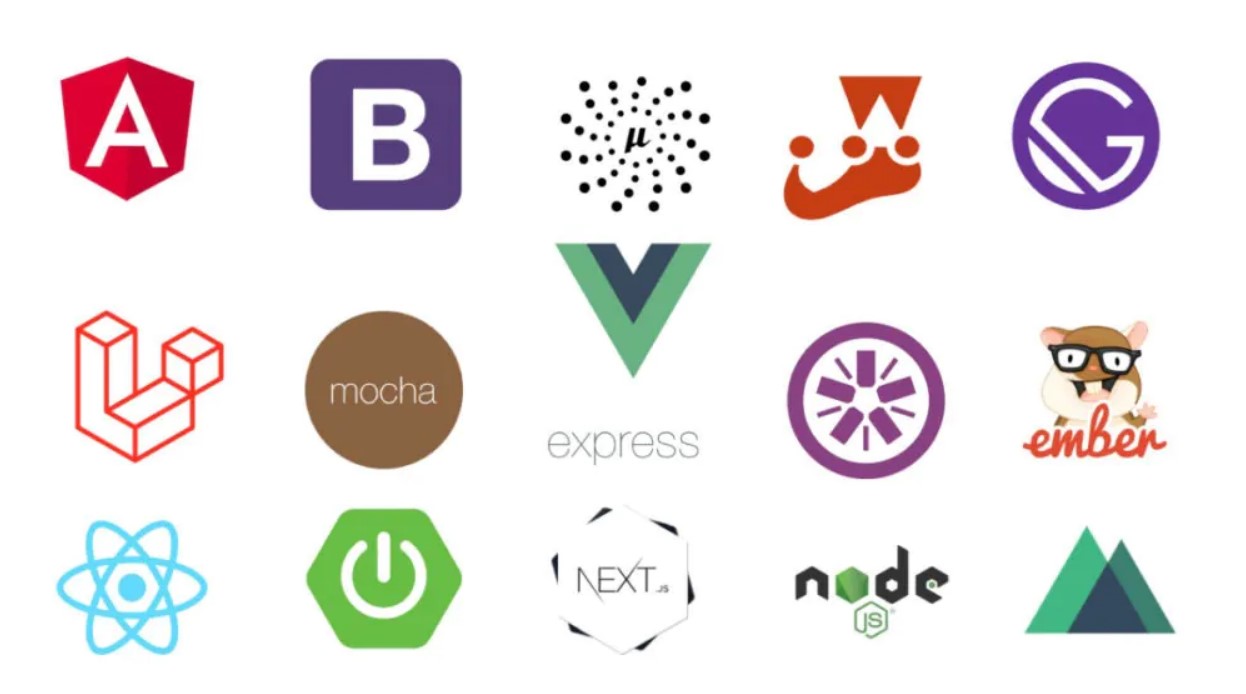Best JavaScript Frameworks for Robust Web Development

JavaScript Frameworks – There are a number of the latest JavaScript frameworks available for web developers with diverse pros and cons. JavaScript Frameworks give JavaScript developers the basic foundation needed for developing JavaScript applications. This saves JavaScript developers the stress of beginning from scratch by using an operational base to get things going.
In JavaScript Frameworks, this base holds a collection of JavaScript code libraries. The libraries compile code that extracts particular functionality for the specific sort of app you may be working on. In reality, the JavaScript framework will determine the structure of the complete application.
What Does a JavaScript Framework Do?
Every JavaScript framework assists a particular purpose. JavaScript is a durable option for web development, and several of its framework’s spin around this undertaking.
Building web apps and websites from origin to end can take quite a bit of work. Web frameworks – or JavaScript frameworks – profit because each website and web app has regular features.
In this method, you can study the term framework quite literally. Businesses also rely on JavaScript frameworks as a design for the overall assistance and shape of an outer framing. Software frameworks do the same.
JavaScript frameworks contribute pre-written JavaScript code that provides standard programming features, finally easing development.
Best JavaScript Frameworks for 2022
Let us see the most used JavaScript Frameworks available in the market. This list of JavaScript frameworks is prepared by the research, forum analysis, and expert developer’s reviews.
1. React JS
React JS is an open-source and best JavaScript Framework generally used to create responsive and active user interfaces (UI). It is apprehended to be SEO-friendly and hence is favored by developers who build e-commerce websites.
React.js development is most ideal when a superior performing enterprise app is required to be delivered to its user-base. User interfaces like Instagram and Facebook empower it.
Key features
- Virtual Document Object Model (DOM)
- One-way data-binding only
- Made up of various elements that can be reused
- Cross-platform performance
Pros
- very simple to learn and use
- It comes with a set of efficient tools
- Helps with performance enhancement
- Smaller in size
- Ability to test and debug quickly
Cons
- Regular upgrades need developers to sustain recent learning changes
- It is not a comprehensive technology. It needs to be used with other F/Ms.3.
2. Vue JS
Vue JS is another one of the best JavaScript frameworks generally used in developing cross-platform apps and websites. It also supports the build of powerful Single Page Applications (SPAs).
Vue.js offers a simple and swift fix for apps, user interface, and engaging web-based interface development. It can empower modern-day single-page web-based apps.
Key features
- Cost-effective virtual DOM view option
- It comes with a built-in component that helps with CSS transitions and animations
- Precise two-way data binding preferences
- Easy to understand and learn
Pros
- Simple to integrate
- Small in size
- Offers two-way communication
- Flexible framework
Cons
- Lack of essential plugins
- Not suitable for extensive scaling
- Has language barriers
- Too flexible for good
3. Angular
It is one of the most powerful and best JS Frameworks in 2022. Here are the top characteristics of Angular.
It enables transmission of all the contents right from the server to the precise browser and helps in arranging all the created web pages concurrently.
Angular has a precise NativeScript for native applications while facilitating an Ionic framework for hybrid-based apps. AngularJS is a cross-platform framework. The code of the framework is entirely clean, easy to comprehend and comprises very less frequency of errors through its precise controller and data rendering technique.
Key features
- Ability to offer high-performance, progressive web-pages
- Can work across multiple operating systems
- It provides an instinctive and progressive API
- Aptitude to get smart code at the ends
- Provides immediate error discovery and feedback selections
Pros
- Flawless synchronization amid view and model
- Alterations are promptly showcased right in the view
- Capability to isolate out the view and data sets
Cons
- More complex F/M to learn
- The developer needs to learn MVC
- Heavier framework
4. Ember JS
Ember JS is another commonly used JavaScript framework for front-end that helps create scalable SPAs (Single Page Applications). Ember can be used to develop frameworks for the web, mobile, and desktop versions.
Ember has a precise widget-based style, known as Ember components. It possesses the handlebars layout and its architecture enables developers to own the application-based HTML tags.
Key features
- Large teams can easily use it
- It comes with computed properties
- It has larger than 1500 add-ons that only have to grow with time
- Reusable and easy to maintain too
Pros
- Seamless URL support
- Offers client-rendering services
- Well-blended data layers
- Minimizes DOM
Cons
- Slightly more complicated to learn
- Very opinionated
- Not very fast and efficient
5. BackBoneJS
Backbone.js enables developers to build one-page applications and front-end much simpler utilizing effective JavaScript functions. It offers diverse sets of building blocks for accumulating client-side web-based applications. These blocks mainly consist of explicit events, precise views,models, and routers.
Key features
- Open-source library comprising 100+useful extensions
- It turns the coding straightforward and highly organized
- Enable client-side web and mobile apps with precise formats
Pros
- Enables own development and architecture decision-makings
- Mix and match elements best for your application requirements
- Possess immense community and massive ecosystem for support
Cons
- Poor levels of user experience for big-sized data structures
- Backing diverse URI scheme can be tough to deal
- The lack of a precise and explicit controller building block
06. Meteor.JS
MeteorJS is useful in developing applications through a do-it-all framework. It assists in creating production web and mobile applications and is utilized by leading organizations like Ikea and Workpop.
It is a highly effective tool for a beginner exploring the wide scope of application development and helps in the procedure of developing a straightforward app.
Key features
- Provides a full-stack solution for building and deploying web-based applications
- Enables developing dynamic and real-time applications from beginning
- Use same code for web as well as mobile-based applications in diverse projects
Pros
- Large community offers the framework superior flexibility and endurance
- Cross-platform and enable app implementations in one single place
- The precise direction of its development meticulously follows its user-base
Cons
- If programmers put added dependence on pre-built packages – they struggle
- If you are merely making a webapp, it might be easier to utilize Express
- Difficult to develop a mobile web-app operate as proficient as with native
07. Gatsby JS
Gatsby JS is an open-source front-end framework perfect for creating dynamic and exact websites that function seamlessly. Through Gatsby, its user-base can receive information and insights from any of the data set sources.
Rather of being an SSR, this particular framework communicates content on the client-side right in the build time. This assists in delivering matchless security and SEO results on a long-term basis.
Key features
- Competence to syndicate data from several sources
- Capability to write in JavaScript or SCSS or LESS
- Works seamlessly with various Content Delivery Networks (CDN)
Pros
- Easy and cost-effective scalability
- non-existent attack surface
- Very accessible
Cons
- The constant need to update content
- It can be expensive to implement and manage
08. Svelte JS
Svelte JS was released in 2016 and is a free front-end JS Framework. You can create elements using Svelte JS in languages you are satisfied with (JavaScript, HTML, or CSS). There is a significant difference between those frameworks. Svelte doesn’t use Virtual DOM like React and Vue.
It runs at build time and converts your components into code that runs in the browsers, whereas others do the operations in the browser itself.
Key features
- No virtual DOM
- This converts codes into Vanilla JavaScript
- Very reactive
Pros
- Lightweight and easy to implement
- Lesser boilerplate
- Very easy to learn
- It comes with a built-in reactive store
Cons
- Not an extremely recognized framework
- There is continuous requirement to explore and update
- Not many such tools in the market
- Smaller-sized community and ecosystem
09. Next JS
Next, JS is another commonly used JavaScript framework for the front-end that Vercel builds. It allows developers to create both static and dynamic JAMstack websites and is used by multinationals worldwide.
Based on React, this JavaScript framework helps in achieving comprehensive server-side rendering. It’s designed with the aim of ‘develop once, run everywhere and provides static generations as well, making mobile and web app development more accessible.
Key features
- Automatic routing
- Server rendering
- It responds well with other ecosystems, including React framework and Angular
- Automatically prefetches pages
Pros
- Adaptable and responsive JS
- Helps meet sales and traffic goals
- Offers unique user experience
- Has built-in CSS support
- Needs minimal or no initial configuration
Cons
- It becomes expensive to customize
- Minimal number of plugins only
- It needs time to build and manage the framework
10. Nuxt JS
Nuxt is a front-end FM that is developed using Vue JS. Though recently, several websites and trademarks are proactively adopting this to make their website application.
Grounded on Vue, Nuxt JS presents itself amongst the topmost open-source backend JavaScript frameworks with the capability to build superior functionality-packed web applications. It crafts an advanced development environment and is called a Vue-based enhancer.
Key features
- Offers exceptional SEO improvements
- Created using a robust modular architecture. There are longer than 50 modules to pick from
- Server-side rendered
- Supports static website generation
Pros
- Capability to create customized social sharing windows for users
- Can create universal apps
- Automatic code splitting
Cons
- Most common plugins are not available
- Cannot effectively handle high traffic
- It does not work particularly well with other custom libraries
